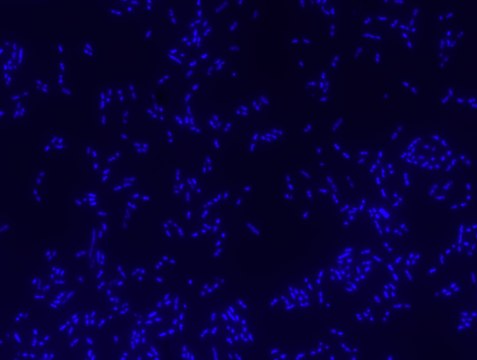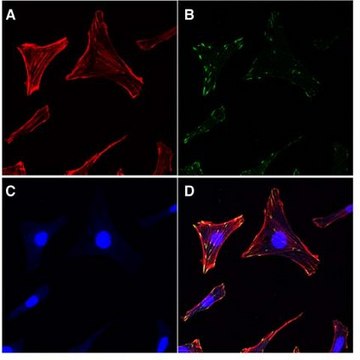MBD0035
Bacterial negative control FISH probe - Cy3
Probe for fluorescence in situ hybridization (FISH),20 μM in water
Se connecterpour consulter vos tarifs contractuels et ceux de votre entreprise/organisme
About This Item
Code UNSPSC :
12352200
Nomenclature NACRES :
NA.55
Produits recommandés
Niveau de qualité
Technique(s)
FISH: suitable
Fluorescence
λex 550 nm; λem 570 nm (Cy3)
Conditions d'expédition
dry ice
Température de stockage
−20°C
Description générale
Fluorescent In Situ Hybridization technique (FISH) is based on the hybridization of fluorescent labeled oligonucleotide probe to a specific complementary DNA or RNA sequence in whole and intact cells.1 Microbial FISH allows the visualization, identification and isolation of bacteria due to recognition of ribosomal RNA also in unculturable samples.2
FISH technique can serve as a powerful tool in the microbiome research field by allowing the observation of native microbial populations in diverse microbiome environments, such as samples from human origin (blood3 and tissue4), microbial ecology (solid biofilms5 and aquatic systems6) and plants7.
Prokaryotic single cell life forms are divided into two domains, called Bacteria and Archaea, originally categorized as Eubacteria and Archaebacteria.8 However both terms, Eubacteria and Bacteria are still being used in microbiology.
The Negative control non-specific, nonsense probe, is used in the FISH experiments to detect nonspecific binding of the probes and set the appropriate conditions for the experiment.9
The negative control probe was used in FISH technique on various samples such as, pure culture (as described in the figure legends) and blood cultures9,10.
It is strongly recommended to include positive and negative controls in FISH assays to ensure specific binding of the probe of interest and appropriate protocol conditions. We offer positive (MBD0032/33) and negative (MBD0034/35) control probes, that accompany the specific probe of interest.
FISH technique can serve as a powerful tool in the microbiome research field by allowing the observation of native microbial populations in diverse microbiome environments, such as samples from human origin (blood3 and tissue4), microbial ecology (solid biofilms5 and aquatic systems6) and plants7.
Prokaryotic single cell life forms are divided into two domains, called Bacteria and Archaea, originally categorized as Eubacteria and Archaebacteria.8 However both terms, Eubacteria and Bacteria are still being used in microbiology.
The Negative control non-specific, nonsense probe, is used in the FISH experiments to detect nonspecific binding of the probes and set the appropriate conditions for the experiment.9
The negative control probe was used in FISH technique on various samples such as, pure culture (as described in the figure legends) and blood cultures9,10.
It is strongly recommended to include positive and negative controls in FISH assays to ensure specific binding of the probe of interest and appropriate protocol conditions. We offer positive (MBD0032/33) and negative (MBD0034/35) control probes, that accompany the specific probe of interest.
Application
Probe for fluorescence in situ hybridization (FISH), negative control probe used to detect nonspecific binding.
Caractéristiques et avantages
- Detection of nonspecific binding of tested probes.
- Verification of FISH results accuracy.
- Calibration of FISH experiment appropriate conditions.
- Can be used to control for nonspecific binding in variuos samples such as, blood cultures and pure cultures.
- The ability to detect bacteria in its natural habitat is an essential tool for studying host-microbiome interaction.
Code de la classe de stockage
12 - Non Combustible Liquids
Classe de danger pour l'eau (WGK)
nwg
Point d'éclair (°F)
Not applicable
Point d'éclair (°C)
Not applicable
Faites votre choix parmi les versions les plus récentes :
Certificats d'analyse (COA)
Lot/Batch Number
It looks like we've run into a problem, but you can still download Certificates of Analysis from our Documents section.
Si vous avez besoin d'assistance, veuillez contacter Service Clients
Déjà en possession de ce produit ?
Retrouvez la documentation relative aux produits que vous avez récemment achetés dans la Bibliothèque de documents.
Notre équipe de scientifiques dispose d'une expérience dans tous les secteurs de la recherche, notamment en sciences de la vie, science des matériaux, synthèse chimique, chromatographie, analyse et dans de nombreux autres domaines..
Contacter notre Service technique








